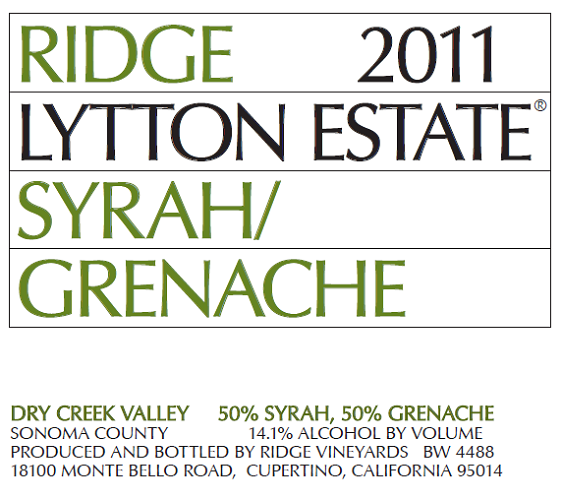
2011 Lytton Estate Syrah Grenache
Wine Information
50% Syrah, 50% Grenache
Vintage
2011
Vineyard
Lytton Springs
Appellation
Dry Creek Valley
Alcohol By Volume
14.1%
Vintage Notes
A cold summer slowed ripening, but careful thinning assured intensity of flavor at harvest. The syrah, destemmed but not crushed, fermented with the grenache. At pressing, three fractions were held separate, and the best added to the free run. Focused fruit and soft tannins were the criteria for selection at assemblage. Appealing as a young wine, it will be at its best over the next six to seven years.
History
Ridge became involved with grenache quite by accident when, in 1972, we first harvested the vines planted in 1902 on the eastern hills of Lytton Springs. Though we didn’t know it then, one of the hills had a high percentage of grenache interplanted with small amounts of zinfandel and petite sirah. We purchased the eastern vineyards in 1991 and identified the varietal percentages in each parcel; in 1992, those old mixed vines, harvested separately, produced our first Grenache/Zinfandel. Ridge bought Lytton Springs’ western vineyards in 1995, acquiring a mixed grenache block planted in 1963, and a straight grenache block planted in 1991. We currently have 3.1 acres of mature syrah, and 6.6 acres of syrah (together with a small amount of viognier) planted in 2001.
Growing Season
Rainfall: 40 inches (above average)
Bloom: Late May
Weather: Wet spring and atypically cool summer, with no sustained heat spells.
Winemaking
Harvest Dates: 28 September
Grapes: Average Brix 24.7˚
Fermentation: 100% destemmed, but uncrushed and fermented as whole berries in open top tanks. No inoculation. 100% natural primary and secondary fermentations. Juice circulated through the cap of skins daily. Pressed at seven days.
Barrels: Air-dried american oak (32% new, 29% one and two years old, 18% three years old and 21% five years old)
Aging: Twenty-three and a half months in barrel.
Hand harvested, sustainably grown, estate grapes; destemmed and left uncrushed; fermented on the native yeasts, followed by full malolactic on the naturally occurring malolactic bacteria; during fermentation, 0.45 grams/liter tartaric acid added to three fermenters; oak from barrel aging; minimum effective sulfur for this wine (35 ppm at crush, 90 ppm over the course of aging); pad filtered at bottling. In keeping with our philosophy of minimal intervention, this is the sum of our actions.
Consumer Tasting Notes
Average Rating: 89.5
No. of Tasting Notes: 39
View this wine on CellarTracker
Wait!
In order to qualify for user related discounts, you must log in before proceeding with checkout. Click the button below to log in and receive these benefits, or close the window to continue.
Log In